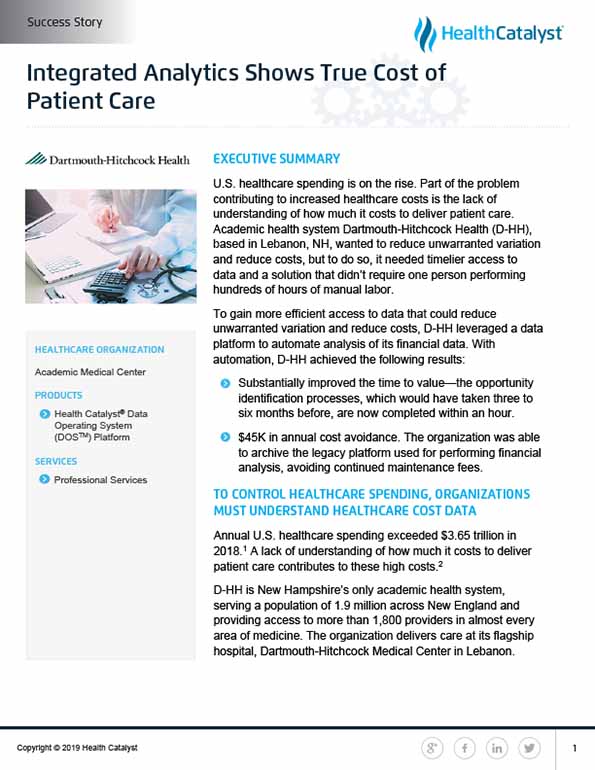U.S. healthcare spending is rising, partially due to a lack of clarity on the actual costs of delivering patient care. Dartmouth-Hitchcock Health aimed to reduce unwarranted variation and costs by improving data access. The organization utilized a data platform to automate financial data analysis, minimizing manual labor and enhancing efficiency.
U.S. healthcare spending is on the rise. Part of the problem contributing to increased healthcare costs is the lack of understanding of how much it costs to deliver patient care. Academic health system Dartmouth-Hitchcock Health (D-HH), based in Lebanon, NH, wanted to reduce unwarranted variation and reduce costs, but to do so, it needed timelier access to data and a solution that didn’t require one person performing hundreds of hours of manual labor.
To gain more efficient access to data that could reduce unwarranted variation and reduce costs, D-HH leveraged a data platform to automate analysis of its financial data.
Annual U.S. healthcare spending exceeded $3.65 trillion in 2018.1 A lack of understanding of how much it costs to deliver patient care contributes to these high costs.2
D-HH is New Hampshire’s only academic health system, serving a population of 1.9 million across New England and providing access to more than 1,800 providers in almost every area of medicine. The organization delivers care at its flagship hospital, Dartmouth-Hitchcock Medical Center in Lebanon.
D-HH had developed and implemented a cost accounting system for both its hospital and physician services. While the health system had invested substantial resources in integrating its cost and margin data, it still required a substantial investment in manual labor to weave the financial data together with clinical data to identify opportunities to reduce unwarranted variation and decrease cost.
Although the output of those manual labor hours was incredibly helpful and leadership depended on it to inform improvement initiatives, the process was inefficient, and data was stale by the time it was ready to distribute. The analyst could only produce healthcare cost data twice a year because developing, coding, and piecing the data together took six months. Leaders and physicians would then look at the data to identify potential unwarranted variation, and the analyst would have to go back to the database, write new code, and pull out data for the encounter, procedure, or visit of interest. The team could only evaluate one focus area every six months, limiting its ability to use the data to drive improvement.
To reduce unwarranted variation and reduce costs, D-HH needed more timely access to data and a solution that didn’t depend on one person performing hundreds of hours of manual labor.
D-HH used the Health Catalyst® Data Operating System (DOS™) and a robust suite of analytics applications to develop the Patient-Focused Economic Analysis (PFEA) analytics application. The PFEA analytics application automates the analysis of its financial data.
The health system can now review clinical, financial, and operational performance measures in a consumable way, and can leverage the data to take timely, appropriate actions to improve performance against key outcomes, such as charges and expected reimbursement.
D-HH uses the PFEA analytics application to identify clinical variation and determine whether it is unwarranted. The health system partners with physicians and service line leaders to conduct an opportunity analysis—reviewing variation, identifying if the variation is unwarranted, and assessing if there is an opportunity to decrease unwarranted variation and decrease costs. The analytics application includes variation by DRG, including identifying the number of dollars for each opportunity. Potential opportunities appear by diagnosis/procedure or by provider (see Figure 1).

With access to a comprehensive data set, D-HH can quickly drill into opportunities and has already identified opportunities to improve the specificity and accuracy of clinical documentation, decrease delays in care related to differences in service delivery on weekends, and substantially reduce drug costs for patients.
D-HH has substantially improved its ability to use clinical, operational, and financial data to perform opportunity analysis, decrease unwarranted variation, and decrease costs. The organization has:
“We can now perform a comprehensive financial analysis, and I’m amazed by how flexible and nimble we now are.”
– Elizabeth Stedina, MBA, MS, VP of Data Analytics
D-HH has initiated a formal project to expand the use of the analytics application to improve its opportunity identification process further, enabling the organization to drive down healthcare costs and improve outcomes.




